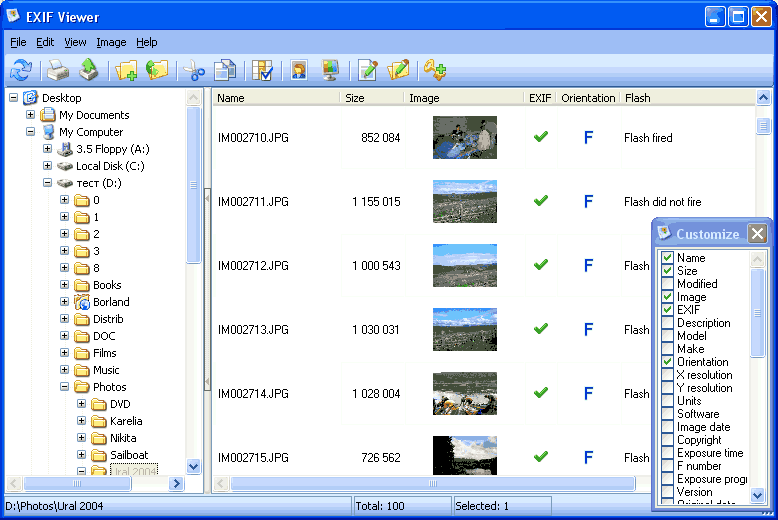
- #Full exif data viewer install
- #Full exif data viewer tv
Selecting a region changes the language and/or content on. Metadata that is stored in other formats, such as EXIF, IPTC (IIM), and TIFF, is synchronized and described with XMP so that it can be more easily viewed and managed. For example, you can save metadata from one file as a template, and then import the metadata into other files. XMP facilitates the exchange of metadata between Adobe applications and across publishing workflows. For all other file formats supported by Lightroom Classic (JPEG, TIFF, PSD, and DNG), XMP metadata is written into the files in the location specified for that data. To avoid file corruption, XMP metadata is stored in a separate file called a sidecar file.

In the case of camera raw files that have a proprietary file format, XMP isn’t written into the original files. You can use metadata to streamline your workflow and organize your files.įile information is stored using the Extensible Metadata Platform (XMP) standard. This standard includes entries for descriptions, keywords, categories, credits, and origins. Lightroom Classic also supports the information standard developed by the International Press Telecommunications Council (IPTC) to identify transmitted text and images. For example, most digital cameras attach some basic information about a file, such as height, width, file format, and the time the image was taken. Metadata is a set of standardized information about a photo, such as the author’s name, resolution, color space, copyright, and keywords applied to it.
Preview, export, and upload web photo galleries. Work with web gallery templates and settings. Work with print job options and settings. Open and edit Lightroom Classic photos in Photoshop or Photoshop Elements. Export to hard drive using publish services. Correct distorted perspective in photos using Upright. Watermark your photos in Lightroom Classic. 
Personalize identity plates and module buttons.Display the Library on a second monitor.Set preferences for working in Lightroom Classic.Enhance your workflow with Lightroom Classic.The Filename Template Editor and Text Template Editor.Import photos from a folder on a hard drive.Import photos from a camera or card reader.Sync Lightroom Classic with Lightroom ecosystem.
#Full exif data viewer tv
Adobe Photoshop Lightroom for mobile and Apple TV | FAQ. Using Adobe Stock in Creative Cloud apps. Feature summary | Lightroom CC 2015.x/Lightroom 6.x releases. If you are taking them from a drone, it’s theoretically possible that the drone can add metadata that indicates the exact extent of the land seen in the image, but Lightroom would have no knowledge of this extra metadata. I don’t know much about overlays in Google Earth, but unless you’re taking photos from a drone, I wouldn’t think they’d be appropriate for overlyaing. Photo locations in Lightroom are (intended to be) the location of the camera at the moment the shot was taken, and could be a long distance from what’s seen in the photo. Can you explain how your tool correctly positions the coordinates of the image from the metadata onto Google Earth? Also, do you know of a more precise way to overlay a georeferenced image onto Google Earth? Is there a difference between default coordinate systems? Thanks! Google supplies anchors to reposition and resize the image, but this seems totally against the point of importing a georeferenced image. However, when I use the image overlay tool in Google Earth Pro, the tiff file is not positioned correctly over the field. I noticed that when I open the “Map via embedded coordinates” link (I am using Google) that the pin is indeed positioned correctly over the area of interest (a vineyard). I am working with georeferenced images (RedEdge multi-spectral sensor). Many have their Exifįinally, I should note that my viewer makes use of Phil Harvey's most Alternatively, you can use the Browse option on the startup screen to dive into the device’s internal storage for deeper access to your images. Tap any photo for which you want to see or edit the data. And the EXIF data window remains on top of IrfanViews main window. I use the viewer a lot on images I see in the Digital Photography Review Samples and The photos view defaults to the Recent menu, which opens all pictures recently taken on or added to the device. On the other hand, the EXIF data are updated when an image is already displayed in the main viewer and I display the next one in the directory (using the spacebar or the arrow in the toolbar). You're viewing a page with an image you want to check out, just click theīutton and you'll be whisked to a new tab showing the image's data. #Full exif data viewer install
Safari, you have the added benefit that you can install an Exif-viewerīutton on your button-bar toolbar.

You can also check images on your local hard drive - images directly fromĪ camera generally have the most information.
A Qualitative Analysis of NEF Compression. Photoshop Calendar-Template-Building Script.







 0 kommentar(er)
0 kommentar(er)
